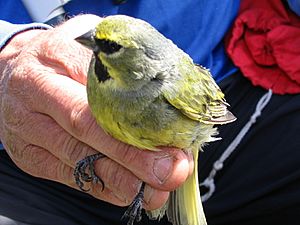Tanager facts for kids
Quick facts for kids Tanagers |
|
|---|---|
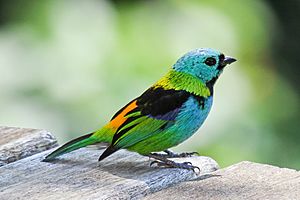 |
|
| Green-headed tanager, Tangara seledon | |
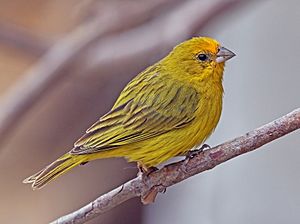 |
|
| Saffron finch (Sicalis flaveola) male | |
| Scientific classification |
|
| Kingdom: | Animalia |
| Phylum: | Chordata |
| Class: | Aves |
| Order: | Passeriformes |
| Superfamily: | Emberizoidea |
| Family: | Thraupidae Cabanis, 1847 |
| Genera | |
|
Many: see text |
|
Tanagers are a large group of colorful birds. They belong to the bird family called Thraupidae. These birds are found mostly in the Neotropical region, which includes Central and South America. The tanager family is the second-largest bird family in the world. About 4% of all bird species are tanagers. They make up 12% of all birds found in the Neotropical areas.
Scientists used to think this family had about 240 species. Most were brightly colored and ate fruit. But with new ways to study birds, like looking at their DNA, scientists learned more. They found that some birds once called tanagers actually belong to other families. For example, Euphonia and Chlorophonia are now part of the finch family. Also, birds like the scarlet tanager are now in the cardinal family. This shows how science helps us understand nature better!
What Do Tanagers Look Like?
Tanagers are small to medium-sized birds. The smallest one is the white-eared conebill. It is about 9 centimeters (3.5 inches) long. It weighs only 6 grams (0.2 ounces). That's barely more than a paperclip!
The longest tanager is the magpie tanager. It can be 28 centimeters (11 inches) long. The heaviest is the white-capped tanager. It weighs about 114 grams (4 ounces). Both male and female tanagers are usually the same size.
Many tanagers have bright colors. Some are black and white. The males are often much brighter than the females. Young birds are usually duller in color. Most tanagers have short, rounded wings. Their bill shape helps them find food.
Where Do Tanagers Live?
Tanagers live only in the Western Hemisphere. This means they are found in North, Central, and South America. They mostly live in warm, tropical areas.
About 60% of all tanager species live in South America. A large number, about 30% of these, live in the Andes mountains. Many tanager species live only in a small area. This is called being endemic.
How Do Tanagers Behave?
Most tanagers live in pairs. Some live in small groups of three to five birds. These groups might be parents with their young. You might also see them in mixed flocks with other bird species. Many tanagers have simple songs. But some species have very fancy songs.
What Do Tanagers Eat?
Tanagers are omnivores. This means they eat both plants and animals. Their diet changes depending on the type of tanager. They eat fruits, seeds, and nectar. They also eat parts of flowers and insects.
Many tanagers pick insects off branches. Some find insects in holes in wood. Other species look for insects under leaves. Some tanagers wait on branches. When they see a flying insect, they catch it in the air. Different tanager species can live in the same area. Their special eating habits help them avoid competing for food.
Reproduction and Life Cycle
The breeding season for tanagers is different depending on where they live. In cooler areas, it's from March to June. In South America, it's from September to October. Some tanagers protect their own area. Others build their nests closer together.
We don't know a lot about how tanagers raise their young. Male tanagers show off their bright feathers. They do this to attract mates and scare away other males. Some species do special dances. They might bow or lift their tails.
Most tanagers build cup nests. They place these nests on branches in trees. Some nests are almost round. The entrance is usually on the side. Nests can be shallow or deep. The type of tree and nest location vary by species. Most nests are hidden in thick plants.
A female tanager usually lays three to five eggs. The female builds the nest and sits on the eggs. The male might bring her food while she is on the nest. Both parents feed the young birds. Some species have "helpers." These helpers are often young birds from the year before. They help feed the new babies.
How Scientists Classify Tanagers
The tanager family, Thraupidae, was named in 1847. It was named by a German bird expert, Jean Cabanis. The Thraupis genus is the main type for this family.
The Thraupidae family is part of a larger group of over 800 birds. These are called the New World, nine-primaried oscines. In the past, birds were grouped by what they ate. For example, nectar-eaters were honeycreepers. Seed-eaters were finches or cardinals. Fruit-eaters were tanagers.
But this old way of grouping birds had problems. Scientists found that birds that looked similar were not always closely related. Since the 1990s, scientists have used molecular phylogenetic studies. This means they look at bird DNA. This has completely changed how bird families are organized.
Now, the tanager family includes many types of birds. It has large-billed seed eaters. It also has thin-billed nectar feeders. It includes birds that pick insects off leaves. And, of course, it still has fruit-eaters.
Because of these changes, some bird names can be confusing. For example, many birds with "tanager" in their name are no longer in the tanager family. The scarlet tanager is now in the cardinal family. Also, many birds in the tanager family now have "finch" in their name.
A big study in 2014 showed that many of the old groups of tanagers were not correct. Scientists then reorganized the family. They added six new groups. They brought back eleven old groups. And they removed seven groups.
As of July 2020, the tanager family has 383 species. These are divided into 15 smaller groups called subfamilies. They are also divided into 106 genera. You can find a full list in the article List of tanager species.
Main Tanager Groups (Subfamilies)
Here are some of the main groups within the tanager family:
Catamblyrhynchinae
This group has only one species, the plushcap. It's a unique bird with no close relatives.
- Catamblyrhynchus – plushcap
Charitospizinae
This group also has only one species, the coal-crested finch. It lives in Brazil's grasslands. Both male and female birds have a crest on their heads.
- Charitospiza – coal-crested finch
Orchesticinae
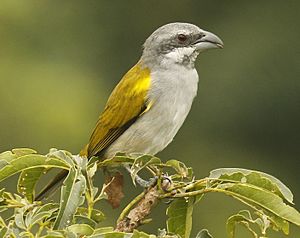
These two species have large, thick bills.
- Orchesticus – brown tanager
- Parkerthraustes – yellow-shouldered grosbeak
Nemosiinae
These birds are brightly colored. Males and females often look different. Most of them fly in groups of their own kind.
- Nemosia – 2 species
- Cyanicterus – blue-backed tanager
- Sericossypha – white-capped tanager
- Compsothraupis – scarlet-throated tanager
Emberizoidinae
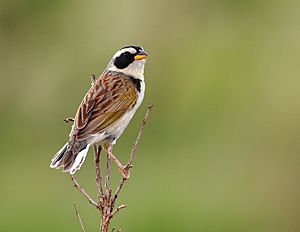
These birds live in grasslands. They used to be in the finch family.
- Coryphaspiza – black-masked finch
- Embernagra – 2 species
- Emberizoides – 3 species
Porphyrospizinae
These birds have yellow bills. The blue finch used to be in the cardinal family. The others were in the finch family.
- Incaspiza – 5 species: Inca finches
- Rhopospina – mourning sierra finch
- Porphyrospiza – 3 species
Hemithraupinae
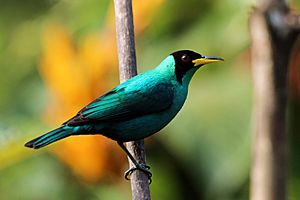
Males and females in this group look different. Many have yellow and black feathers. Most have thin bills.
- Chlorophanes – green honeycreeper
- Iridophanes – golden-collared honeycreeper
- Chrysothlypis – 2 species
- Heterospingus – 2 species
- Hemithraupis – 3 species
Dacninae
In this group, males are blue and females are green.
- Tersina – swallow tanager
- Cyanerpes – 4 species: honeycreepers
- Dacnis – 10 species
Saltatorinae
These birds mostly live in trees. They have long tails and thick bills. They used to be in the cardinal family.
- Saltatricula – 2 species
- Saltator – 14 species: saltators
Coerebinae
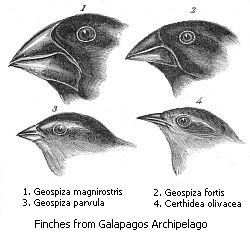
This group includes Darwin's finches. These famous birds live only on the Galápagos Islands and Cocos Island. Most of them used to be in the finch family. They build dome-shaped nests with side entrances. They have many ways to find food. Some eat nectar, some eat seeds, and some pick insects.
- Coereba – bananaquit
- Tiaris – yellow-faced grassquit
- Euneornis – orangequit
- Melopyrrha – 3 species
- Loxipasser – yellow-shouldered grassquit
- Phonipara – Cuban grassquit
- Loxigilla – 2 species
- Melanospiza – 2 species
- Asemospiza – 2 species
Darwin's finches:
- Certhidea – 2 species
- Platyspiza – vegetarian finch
- Pinaroloxias – Cocos finch
- Camarhynchus – 5 species
- Geospiza – 9 species
Tachyphoninae
Most of these birds live in lowlands. Many have special features like crests. Males and females often have different colors.
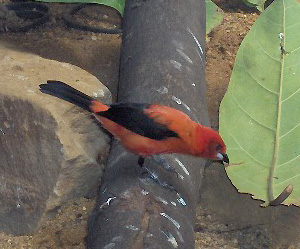
- Volatinia – blue-black grassquit
- Conothraupis – 2 species
- Creurgops – 2 species
- Eucometis – grey-headed tanager
- Trichothraupis – black-goggled tanager
- Loriotus – 3 species
- Coryphospingus – 2 species
- Tachyphonus – 5 species
- Rhodospingus – crimson-breasted finch
- Lanio – 4 species: shrike-tanagers
- Ramphocelus – 9 species
Sporophilinae
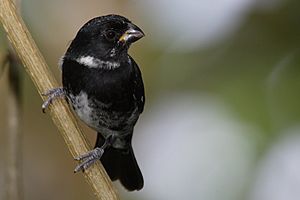
These species were once part of the finch family.
- Sporophila – 41 species: seedeaters and seed finches
Poospizinae
Some of these species were also once in the finch family.
- Piezorina – cinereous finch
- Xenospingus – slender-billed finch
- Cnemoscopus – grey-hooded bush tanager
- Pseudospingus – 2 species: hemispingus
- Poospiza – 10 species
- Kleinothraupis – 5 species hemispingus
- Sphenopsis – 4 species
- Thlypopsis – 8 species
- Castanozoster – bay-chested warbling finch
- Donacospiza – long-tailed reed finch
- Cypsnagra – white-rumped tanager
- Poospizopsis – 2 species
- Urothraupis – black-backed bush tanage
- Nephelornis – pardusco
- Microspingus – 8 species
Diglossinae
This group has many different kinds of birds. Some eat seeds, some eat insects. Some are bamboo specialists. Many live in high mountains.
- Conirostrum – 11 species: conebills
- Sicalis – 13 species
- Phrygilus – 4 species: sierra finches
- Nesospiza – 3 species
- Rowettia – Gough finch
- Melanodera – 2 species
- Geospizopsis – 2 species: sierra finches
- Haplospiza – 2 species
- Acanthidops – peg-billed finch
- Xenodacnis – tit-like dacnis
- Idiopsar – 4 species
- Catamenia – 3 species: seedeaters
- Diglossa – 18 species: flowerpiecers
Thraupinae
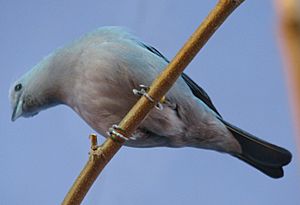
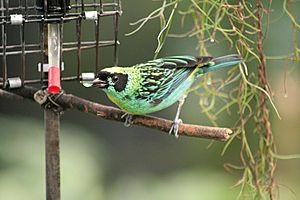
These are what people usually think of as "typical" tanagers.
- Calochaetes – vermilion tanager
- Iridosornis – 5 species
- Rauenia – blue-and-yellow tanager
- Pipraeidea – fawn-breasted tanager
- Pseudosaltator – rufous-bellied mountain tanager
- Dubusia – 2 species: mountain tangers
- Buthraupis – hooded mountain tanager
- Sporathraupis – blue-capped tanager
- Tephrophilus – masked mountain tanager
- Chlorornis – grass-green tanager
- Cnemathraupis – 2 species: mountain tangers
- Anisognathus – 5 species: mountain tangers
- Chlorochrysa – 3 species
- Wetmorethraupis – orange-throated tanager
- Bangsia – 6 species
- Lophospingus – 2 species: crested finches
- Neothraupis – shrike-like tanager
- Diuca – common diuca finch
- Gubernatrix – yellow cardinal
- Stephanophorus – diademed tanager
- Cissopis – magpie tanager
- Schistochlamys – 2 species
- Paroaria – 6 species: cardinals
- Ixothraupis – 5 species
- Chalcothraupis – golden-naped tanager
- Poecilostreptus – 2 species
- Thraupis – 9 species
- Stilpnia – 14 species
- Tangara – 27 species
See also
 In Spanish: Thraupidae para niños
In Spanish: Thraupidae para niños



